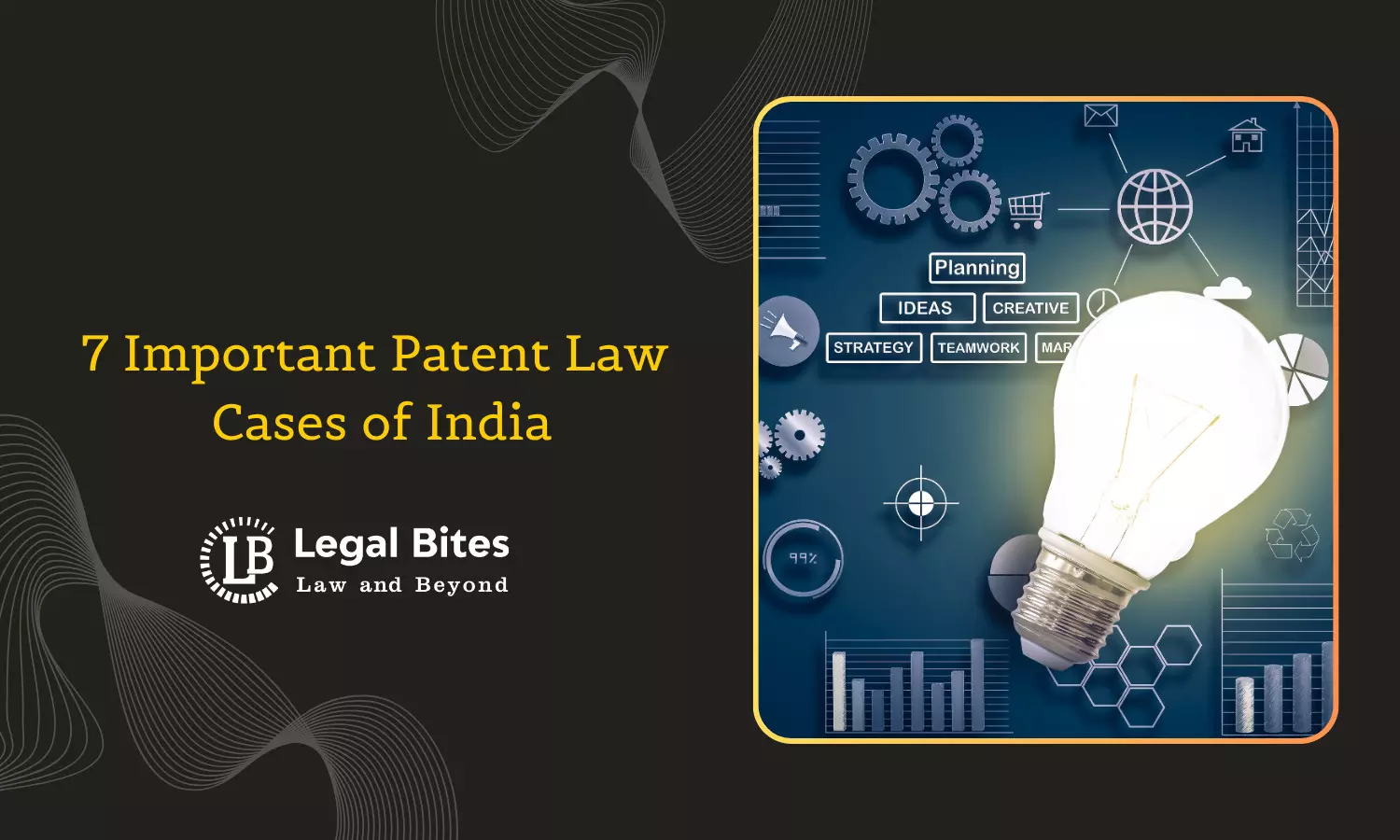Important Patent Law Cases of India: Brief Summaries
Below is a collection of key judicial decisions that have contributed to the development of patent law in India.

Patent law in India plays a crucial role in balancing innovation, public interest, and economic growth. The Patents Act, 1970, as amended in 2005 to comply with the TRIPS Agreement, provides a framework for granting, enforcing, and challenging patents. India follows a first-to-file system and has specific exclusions under Section 3(d) to prevent evergreening of patents, particularly in pharmaceuticals. Courts and tribunals have consistently shaped patent jurisprudence through significant rulings, reinforcing principles of novelty, inventive step, industrial applicability, and compulsory licensing. Below is a collection of key judicial decisions that have contributed to the development of patent law in India.
7 Important Patent Law Cases of India
1. Novartis AG v. Union of India (2013)
This case is one of the most significant judgments in Indian patent law, particularly in the pharmaceutical sector. Novartis applied for a patent for Glivec, a cancer treatment drug, claiming an improvement in efficacy. The Indian Patent Office and later the Supreme Court rejected the application, stating that the drug did not show a significant increase in therapeutic efficacy, as required under Section 3(d) of the Patents Act, 1970. This provision was introduced to prevent evergreening, a practice where minor modifications of existing drugs are patented to extend monopoly rights.
The Supreme Court’s decision reinforced India’s pro-public health stance, ensuring that essential medicines remain affordable and accessible. It was a major victory for generic drug manufacturers and public health advocates, as it reaffirmed the limits on pharmaceutical patenting in India. This judgment also influenced global discussions on patentability standards, especially in developing countries where access to medicine is a critical issue.
2. Bajaj Auto Ltd. v. TVS Motor Company Ltd. (2009)
This case involved a dispute over patented automobile technology. Bajaj Auto claimed that TVS Motor Company had infringed its DTSi (Digital Twin Spark Ignition) technology, which improved fuel efficiency and performance in motorcycles. Bajaj sought an injunction to stop TVS from manufacturing its Flame motorcycle, alleging that it used the same technology. The matter was initially heard by the Madras High Court, which granted an interim injunction against TVS, restraining them from producing the vehicle.
However, when the case reached the Supreme Court, the Court allowed TVS to continue production, stating that an injunction should not be granted without conclusive proof of infringement. The ruling emphasized the principle that patent disputes should be resolved through full trials rather than preliminary injunctions, especially in cases involving technological advancements and fair competition. The judgment helped clarify how Indian courts handle patent infringement claims in the automobile industry.
3. Bayer Corporation v. Union of India (2014)
Bayer challenged the Indian government's decision to impose price control on its patented cancer drug Nexavar (Sorafenib Tosylate), arguing that it violated its intellectual property rights. The government justified its action under the Indian Patent Act, emphasizing the need for affordable access to life-saving medicines. The case highlighted the conflict between patent protection and public health, particularly regarding the compulsory licensing provisions that allow generic manufacturing of essential drugs.
The Supreme Court upheld the government's stance, reinforcing the principle that public interest and accessibility to medicines outweigh excessive pricing by pharmaceutical companies.
4. F. Hoffmann-La Roche Ltd. & Anr. v. Cipla (2008)
In this case, Roche, holding a patent for the cancer drug Erlotinib (sold as "Tarceva"), sued Cipla for intending to launch a generic version, "Erlocip," in India. The Delhi High Court denied Roche’s request for an interim injunction, emphasizing the public interest in affordable medicine over strict patent enforcement.
However, Cipla was required to provide an undertaking to compensate Roche if the final verdict favored it, maintain sales records, and submit annual statements. This case set a significant precedent in balancing patent rights with public healthcare needs in India.
5. Merck Sharp & Dohme Corp. v. Glenmark Pharmaceuticals (2015)
Merck sued Glenmark for patent infringement of Sitagliptin, a diabetes drug. The Delhi High Court granted an injunction in favor of Merck, affirming the importance of protecting pharmaceutical patents unless strong grounds for invalidation exist. In Merck Sharp & Dohme Corporation & Anr. v. Glenmark Pharmaceuticals Ltd. (2015), the Delhi High Court addressed a patent infringement dispute concerning the anti-diabetic drug Sitagliptin. Merck Sharp & Dohme (MSD) claimed that Glenmark’s production and sale of Sitagliptin Phosphate Monohydrate under the brand names ZITA and ZITA-MET infringed their Indian Patent No. 209816, which covered Sitagliptin.
MSD sought a permanent injunction, damages, and other reliefs under Section 48 of the Indian Patents Act, 1970. Glenmark counterclaimed, seeking revocation of the patent, arguing a lack of novelty and inventive step. The Court upheld MSD’s patent rights, ruling that Glenmark’s product fell within the scope of the claims of the suit patent, thus amounting to infringement, and granted an injunction restraining Glenmark from manufacturing and selling the impugned drugs.
6. Dimminaco A.G. v. Controller of Patents (2001)
The appellant challenged the rejection of their patent application for an Infectious Bursitis Vaccine by the Assistant Controller of Patents and Designs (27th December 1999). The application was denied under Section 15 of the Patents Act, 1970, as the Examiner found it non-inventive under Section 2(1)(j) and classified it under the exclusions of Section 5(a)/5(b) for food and drug substances.
The Court overturned the rejection, directing a reconsideration of the application (No.135/Cal/98) within two months, ensuring a fair hearing. No costs were awarded.
7. Monsanto Company v. Coramandal Indag Products (P) Ltd. (1986)
The case Monsanto Company v. Coramandal Indag Products (P) Ltd. (1986) involved a patent dispute over the herbicide Butachlor. Monsanto, claiming patent rights over "Phytotoxic Compositions" and "Grass Selective Herbicide Compositions" containing Butachlor, sued Coramandal for infringement. The defendant argued for revocation under Section 64 of the Patents Act, 1970, asserting that Butachlor and its emulsification process were already publicly known.
The Supreme Court upheld the appellate court's decision revoking Monsanto’s patent, ruling that Butachlor was a known substance globally before the patent claim and that emulsification was a well-established process, not an invention. Consequently, Monsanto’s attempt to claim exclusivity over a non-novel formulation was invalidated.
References
[1] Novartis AG v. Union Of India & Ors, 2013 AIR SCW 2047
[2] Bajaj Auto Ltd. v. TVS Motor Company Ltd., JT 2009 (12) SC 103
[3] Bayer Corporation v. Union of India, Writ Petition No. 1323 of 2013
[4] F. Hoffmann-La Roche Ltd. & Anr. v. Cipla,148 (2008) DLT598
[5] Merck Sharp & Dohme Corp. v. Glenmark Pharmaceuticals, CS(OS) 586/2013
[6] Dimminaco A.G. v. Controller of Patents, 2001 SCC OnLine Cal 901
[7] Monsanto Company v. Coramandal Indag Products (P) Ltd., 1986 SCR (1) 120

